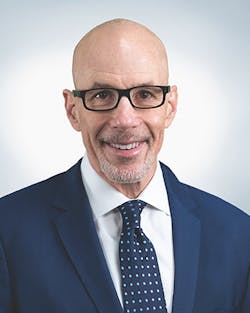As the healthcare delivery system continues on its journey from a fee-for-service to value-based care reimbursement model, the realization of moving from a traditional “sick care” system that has driven the healthcare industry to date to one that provides more affordable, personalized and preventive care, will be critical to achieving success in this movement.
Many industry leaders believe that the tools needed to reimagine and change how to treat illness, and to establish healthy behaviors in patients by focusing on personal details—such as their unique biology, traits, and environmental factors—are already in place, and the next steps needed to shift the paradigm will be around culture, mindset and operational transformation.
To that end, at next week’s Precision Health Virtual Summit, sponsored by healthcare solutions company hc1 and Becker’s Healthcare, Stephen Klasko, M.D., president and CEO of Thomas Jefferson University and the 14-hospital Jefferson Health in Philadelphia, will deliver a keynote session titled, "Beyond Genomics and Cell Therapy," that will discuss healthcare's transition from costly and fragmented sick care to personalized care. In advance of the event, Klasko recently spoke to Healthcare Innovation Managing Editor Rajiv Leventhal about emerging precision medicine models, value-based care, and the many different ways the COVID-19 pandemic has shaken up the healthcare ecosystem. Below is the first part of that discussion; part two will be published in the coming days.
In advance of your upcoming presentation at the Precision Health Virtual Summit, what has your organization learned about emerging precision medicine models and how they’re continuing to advance?
When we first started talking about precision health, we assumed precision health and population health were mutually exclusive. One of them is about a whole bunch of people, and we started to recognize that they're actually very similar. Precision health, in the world of science and medicine, is about helping individuals thrive based on all the factors specific to them, from their genetics to their lifestyle to their environment. On the science side, it is [looking] very specifically at a person's genes and how he or she will react to a certain cancer drug, [for instance]. It’s a matter of predicting, preventing, and curing— customized and precisely. Predicting needs genomics, big data science, and regenerative medicine, and preventing is looking at your genetics and your metabolomics.
Precision health also means that I have to understand why four times as many African Americans from one zip code in Philadelphia that came into our hospital for COVID had bad results or died, compared to Caucasians from another zip code. A lot of that gets into the precision of understanding what that zip code’s social determinants are. We tend to think of social determinants of health as one thing, but it’s different things; in one area it might be housing, in another area it might be food.
The next thing is really starting to get to the person as an individual as opposed to just a number that comes to the hospital. One example of that is in healthcare marketing, which frankly is a joke compared to other sectors. We spend money on putting and billboards and TV ads that have a sick person with cancer coming into a cancer center. In that 30-second ad, the patient comes into the cancer center and walks out smiling. But that doesn’t actually happen and that doesn't tell anybody anything. So at Jefferson, we've learned that we really need to consumer-segment; you might have a 50-year-old with an Oura ring and an Apple Watch, a 26-year-old disconnected person, and 70-year-old cancer patient might who all need to [be reached] differently.
At Jefferson, we partnered with a Hemant Taneja [a managing director of VC firm General Catalyst], and he and I wrote a book together and called UnHealthcare: A Manifesto for Health Assurance. Hemant is a Silicon Valley guy and what we recognized with UnHealthcare is that our whole sick care model is going to give way to an affordable, personalized and preemptive care [model] with genomic sensors and AI-based digital therapies. If you think that’s a pipe dream, all you have to do is look at one of the companies that he started called Livongo Health, which was started five years ago with us as one of their initial partners. The company is basically about treating people with diabetes as people, not as patients who have to come to the office, the ER, or the hospital—people who can thrive without diabetes getting in the way. In just five years, that turned into an $18.5 billion sale to Teladoc. It’s literally starting that consumer revolution of, ‘I want to be treated as an individual.’
You mention how COVID has disproportionately impacted certain races. Now that you have dug into the factors as to why that is, what can a health system like yours do to address that disparity?
We have known this for a long time. We have five academic medical centers in Philadelphia and other than Boston and New York, it’s the greatest concentration of academic centers, with two in the top 30 in the U.S.—Jefferson and Penn. At the same time, we also have among the greatest discrepancy in life expectancy of any city in the country. For a long time we've known that clinical care is actually about 10 percent of a person's health. Environmental and social factors make up the other 40 percent, with 30 percent or so being the behavioral factors, and 20 percent genetics and biology.
So it’s not just what Jefferson can do. It’s embarrassing that the whole healthcare dialogue has been about how we can give more people access to this expensive, fragmented, sick care, insurance-driven model of healthcare. This is during a time when COVID is surging, and health systems and providers have lost $500 billion, while insurers have been tripling and quadrupling their income. There's a great quote I like to use from Upton Sinclair that says, ‘It's hard to get somebody to do something when their salary depends upon them not doing it.’
So what Jefferson first did was change our mission. When I arrived in Philadelphia seven years ago, every academic medical center had the same mission of wanting to be the premier academic medical center in Philadelphia, and be number one for NIH funding. That doesn’t do anything for anybody. So we changed our mission to ‘let’s improve lives.’ As soon as that happened, 25 percent of my personal incentive as president of the university and CEO of the health system became about literally reducing health disparities. So now, I am matching what we are doing to how I get paid. We need the same kind of sort of concentration on how states and the federal government pay for population health. I've told our governor as well as the folks in the Trump administration that nobody should give a cent to Penn, Jefferson, Temple, Drexel, or whoever else, to solve some of these issues. They should give some money for us to work together to solve them.
Here’s one example of that happening. Ken Frazier, the CEO of Merck, grew up in the 18th and Tioga [section of Philadelphia], which is probably the most underserved area in the city. There's a 30-times increased risk of an African American in 18th and Tioga getting a stroke in their lifetime compared with a Caucasian in the suburbs. So Ken came to us and said he wanted to do a stroke prevention [project] and fund it. But instead of doing it at Jefferson, which would be the typical way, he wanted to do it right at 18th and Tioga. We looked at areas there, and it happened to be in Temple’s territory, so we decided to partner with Temple on this project. From that, we will have a Jefferson/Temple Stroke Prevention Unit that people can walk to.
As we talk about the digital transformation of healthcare, it's incredibly important that we don't just look at this as making the wealthy healthier. We need to start to look at how these new technologies will actually start to affect the social determinants. For example, food deserts exist because in my zip code, I can walk to a Whole Foods or Trader Joe's, and there are lots of organic alternatives. But in [Philadelphia’s] Strawberry Mansion neighborhood, the only places one can walk to are bodegas that sell non-diet sodas, chips, and candy. if you think about enlightened health policy, what if the government will [pay your family more] for only healthy food? And by the way, we will get it to you via Instacart or drone delivery; we will partner with Amazon or someone else. Imagine what that would do in terms of affecting childhood obesity, and some of those pre-existing conditions that cause people with COVID to die at an unfortunate disproportionate rate, during the next pandemic?
From a financial perspective, how do you balance your strategic goal of growing Jefferson’s footprint with the operating cost losses you’ve had to deal with as a result of the crisis?
To put this in perspective, there was one week where the news reported that Mayo Clinic furloughed [staff] and cut hours for 30,000 employees to help offset $3 billion in pandemic costs. Another [story] was that COVID-19 pushed Cleveland Clinic to $39.9 million in operating cost losses in Q1. And the AHA reported that hospital financial losses from COVID-19 are expected to top $323 billion in 2020. During that same week, Anthem reported their profits up 14.9 percent, Cigna up 24.6 percent at $1.8 billion profit, United had a $6.6 billion profit quarter, and Centene saw a 100 percent profit increase. So clearly, there's a disconnect. There's no other sector where the middleman would succeed to this level in a crisis.
Jefferson did not furlough or layoff anyone, and that certainly affected our numbers. We had 32,000 employees [at the pandemic’s start] and today we still have 32,000 employees. For this fiscal year, we decided not to fill unfilled positions, but we never furloughed anyone. We made two conscious choices, and those probably cost us about $100 million. One was that we would literally spare no expense in employee safety. [Protective] gowns went up from 20 cents a gown to almost $10 per. We use about 15,000 a day across our 14 hospitals, but we never changed our gown policy. We also never used KN95 masks [as opposed certified N95s]. So that supply chain decision led to a $50 million increased cost, for one.
On the positive side, we had among the lowest employee infectivity rates in the country, around 0.8 percent. We started the year with 250 days cash on hand, but we posted a $200 million loss, and it probably would have been half that if we made some different decisions. Having said that, because we didn’t furlough people, and because we by and large did not lay off people, we're now back to the kind of growth that we had pre COVID—in some areas of our system, that growth was about 10 percent. So in our first quarter [2021] we will report better results than our budget, even during this second COVID surge.
At the end of the day, this taught me two things. One is that you need strategically aligned payer-provider relationships, period. That is an absolute. I don't have to necessarily own all my insurance companies, but I need to find insurers that are willing to really share risk and share reward, as I move cost, access, quality and patient experience.
The second thing is that I need to diversify my portfolio; I can’t depend on people spending $50,000 to get a business degree or an engineering degree in person at Thomas Jefferson University. I can’t have my entire revenue model be about how many people I am getting into hospital beds. The new math we see is philanthropy, venture philanthropy, and most importantly, innovation and strategic partnerships [around] digitization and getting healthcare at home. I foresee a future not too many years from now where I’ll have a healthy net operating income as a not-for-profit, and it might be that some of my actual hospitals are losing money, but our healthcare at home [initiatives] and our strategic partnerships are more than making up for that.



